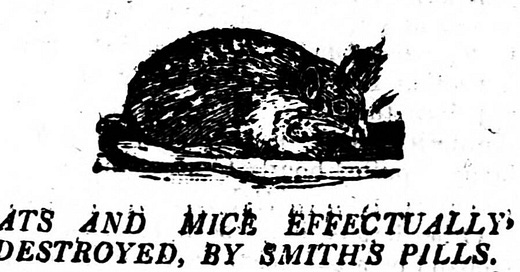Three or Four Hundred Mice
A short story of rodent revenge; PLUS The Premonitions Bureau and Night Tracks
The following tale appeared in October 1841 in the snappily-named London newspaper Lloyd’s Companion to the Penny Sunday Times and People’s Police Gazette:
Madame Duval had a beautiful cat, which, next to her husband, she prized above all things. A Mr. Capelle, whose garden was contiguous to Madame D.’s shrubbery, one day amused himself with shooting the cat, out of vexation, at having the preceding day fired at a dozen hares and birds innumerable without hitting one. Madame Duval had all sorts of mousetraps set in her own house and in the houses of her friends, and when she had collected between three or four hundred mice, she had them put in a large box and sent to Madame Capelle at her country house. Madame Capelle opened the box herself, thinking it contained some new dresses she expected from Paris. The mice escaped and filled the house. At the bottom of the box was a note addressed to Madame C. — “Madame, — Your husband killed my cat, I send you my mice.”
The unfortunate Madame Capelle might have been advised to purchase Smith’s Pills, a rat and mice poison that was advertised in 19th-century newspapers. According to the ads, the remedy “NEVER FAILED”. The pills were “the size of a nut” and “sufficient to destroy the largest rat”. They could be purchased in packets of 24 for one shilling, and anyone purchasing six packets would receive a seventh free. There was also a guarantee: “If rats and mice are found living in any place where the pills are left untouched for three successive nights, if put down according to the directions on the packets, the proprietor will attend personally and kill them gratis.”
Recommended:
Book: The Premonitions Bureau by Sam Knight
In Britain in the 1960s, psychiatrist John Barker teamed up with Evening Standard journalist Chris Fairley to create the Premonitions Bureau. Inspired by tales of people who claimed to have foreseen the terrible Aberfan disaster, Barker and Fairley invited readers to submit their premonitions, which would be catalogued and evaluated—and perhaps used to issue warnings. Most of the submissions could be dismissed, but some, particularly those from piano teacher Miss Middleton and telephone engineer Mr Hencher, warranted further investigation—particularly after Hencher reported a premonition of Barker’s death. A narrative non-fiction book by New Yorker writer Sam Knight, The Premonitions Bureau has an unusual, dream-like atmosphere, entirely suitable for this weird true story. It’s available from Amazon*.
Music: Night Tracks (BBC Radio 3)
I’ve long been a BBC 6 Music man, but I’ve surprised myself by shifting towards BBC Radio 3, specifically one of the station’s late-night shows (which I listen to during the day). Night Tracks is hosted by Sara Mohr-Pietsch and Hannah Peel, and features an eclectic mix of classical and contemporary tracks. I find it to be a perfect writing soundtrack — adventurous and interesting but not obtrusive or distracting. Similarly appealing is Unclassified presented by Elizabeth Alker. Night Tracks (and the companion Night Tracks Mix) and Unclassified are available on BBC Sounds. Night Tracks presenter Hannah Peel is also a musician and composer with a fine catalogue of music, most recently The Unfolding with Paraorchestra, and previously the remarkable Mary Casio: Journey To Cassiopeia with Tubular Brass. Here’s a live track from that album:
I mentioned in the previous newsletter that my new book, The Tyne Bridge, will be released later this year. It’s a narrative history of the iconic bridge and the people who built and use it. It will be published by Hurst on 3 November 2022, and you can pre-order it now from Amazon.* (Pre-orders are really helpful, and you get a price guarantee, meaning you’ll pay the lowest price offered by Amazon between now and the release date.)
Here’s a tremendous photo of some of the bridge workers. I’ve uncovered some amazing stories about them, and have been privileged to speak to some of their descendants. I’m in awe of their skill and bravery in working 200ft above the river and 90ft below the ground. There’ll be lots more photos like this in the book.
Finally, here’s a book token from 1815. See you next time. Please feel free to share and subscribe.


Main source: Lloyd’s Companion…, 17 October 1841
Ads: Links marked with an asterisk (*) are affiliate links. If you use them, we may receive a small payment to help with the running of this free newsletter.






